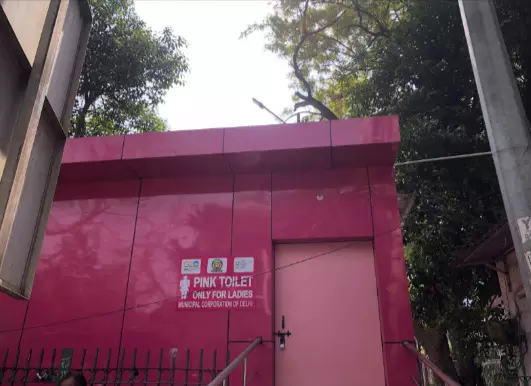
New Delhi's Pink Toilets: Promises and Pitfalls
At 8:00 in the morning, Sarita arrives, draped in a sleek black salwar kameez, ready to open the doors of her modest eatery situated within the upscale enclave of Greater Kailash. From dawn till dusk, she tirelessly dedicates herself to serving a mix of parathas, rice, and assorted delicacies. Her laborious day will draw to a close around 9:00 PM.
As a woman who spends most of her day outside, Sarita finds herself constrained in her options for toilet facilities. She relies primarily on a public toilet a few paces away from her stall. “There is a Pink toilet that was built in 2023, but it has not been operational yet." she laments. "Since then, I've made do with the public toilet, which, while decently maintained, lacks facilities for women's needs."
In Delhi, the scarcity of public toilets for women is compounded by their generally poor maintenance. According to a survey conducted by the Ministry of Housing and Urban Affairs in November 2019, a significant portion of existing facilities are either unusable or in a dirty state. The survey, which covered 1,175 toilets, revealed that 36% were deemed unusable, while an additional 19% were found to be usable but in unsanitary conditions.
Delhi’s pink toilets are struggling.
Responding to the challenges posed by poor maintenance and inadequate public restroom facilities, the National Commission for Protection of Child Rights (NCPCR) partnered with municipal authorities to introduce the Pink Toilet initiative. The inaugural Pink Toilet was unveiled in New Delhi's Vikaspuri area on October 12, 2017, with the explicit goal of furnishing a secure and sanitary environment for women. Outfitted with amenities such as sanitary napkin vending machines and incinerators, these facilities were envisioned as a proactive step toward promoting menstrual hygiene and meeting the sanitation needs of women in urban locales.
However, despite the Pink Toilet initiative's intentions, doubts have arisen regarding its efficacy and implementation.
A 45-year-old woman whose livelihood depends on begging near the Jamia metro station said, “I go to the jungle nearby if I have to use the washroom.” Regarding the Pink Toilet, she explains, "I avoid it due to the associated fee. When I can’t afford food, I can't spare money to use a toilet."
Pink Toilet In Batla House
Operational hurdles continue to plague Pink Toilet facilities, even in areas where they are established. A staff member at the Pink Toilet in Okhla's Batla House revealed that the facility has been shut since December 2023 due to a dispute among women regarding the required payment for restroom use. The worker lamented facing verbal abuse and harassment from women who object to the fee, emphasising that she is merely adhering to what she was told. "I am employed on minimum wage," she said.
The NCPCR had outlined specific provisions for Pink Toilets, including separate facilities for women, adolescent girls, and children, along with amenities like sanitary napkin vending machines and incinerators. However, the ground reality starkly contrasts with these expectations, with many locations failing to provide these essential services.
In India, the challenge of inadequate sanitation is not solely a matter of infrastructure but is also deeply rooted in behavioural patterns. Even when proper toilet facilities are available, many individuals avoid using them. Addressing this issue necessitates comprehensive awareness programs that directly engage with the community. The approach to enhancing sanitation in India should prioritise inclusivity, addressing not only gender disparities but also interconnected issues. For example, in this context, the occupational roles of women and their lack of awareness play a significant role in their limited access to basic facilities such as toilets.
A Pink toilet in the middle of Batla House Market, Okhla
India’s lack of toilets
In India, the prevalence of open defecation remains alarmingly high, with an estimated 595 million people resorting to this practice, constituting more than half of the country's population. This pervasive phenomenon poses significant health risks and contributes to environmental degradation. Women, irrespective of their economic background, are particularly affected by this issue. However, those from lower socio-economic backgrounds encounter even greater hurdles due to their restricted access to alternatives.
The shortage of toilets has persistently been a developmental concern in India. Despite the government declaring India as Open defecation-free in 2019, findings from the National Family Health Survey conducted during 2019-21 indicate that 19 percent of Indian households continue to lack access to toilet facilities. The situation in the National Capital mirrors that of the rest of the nation.
Urban areas, in particular, face a significant scarcity of public toilets, exacerbating the issue at hand. Unlike rural environments, where open spaces and fields provide some respite, urban settings contend with congestion and a dearth of available areas. Consequently, the looming risk of communicable diseases, particularly urinary tract and reproductive tract infections, disproportionately affects women. Furthermore, the added threat of sexual harassment exacerbates the situation, particularly for women residing in slum areas who frequently find themselves in precarious circumstances during early or late hours when they require toilet facilities.
The Union Territory of J&K can serve as a model for other cities and states to emulate. The Directorate of Rural Sanitation, Department of Rural Development, and Panchayat Raj in J&K initiated the construction of the Pink Toilets. This move increased attendance in schools. Moreover, the existence of the Pink Toilets and its facilities allowed teenage girls to continue attending schools even during their menstruation. The initiative has boosted gender equality and is slowly sensitizing people toward the unique sanitation needs of women.
The government’s efforts to construct pink toilets are a commendable step towards achieving sustainable development goals, particularly gender equality and sanitation. Catering to such hygiene and sanitation needs should be a priority for policymakers and development practitioners globally.
Pink toilet in Greater Kailash-2, which has been closed since 2023

